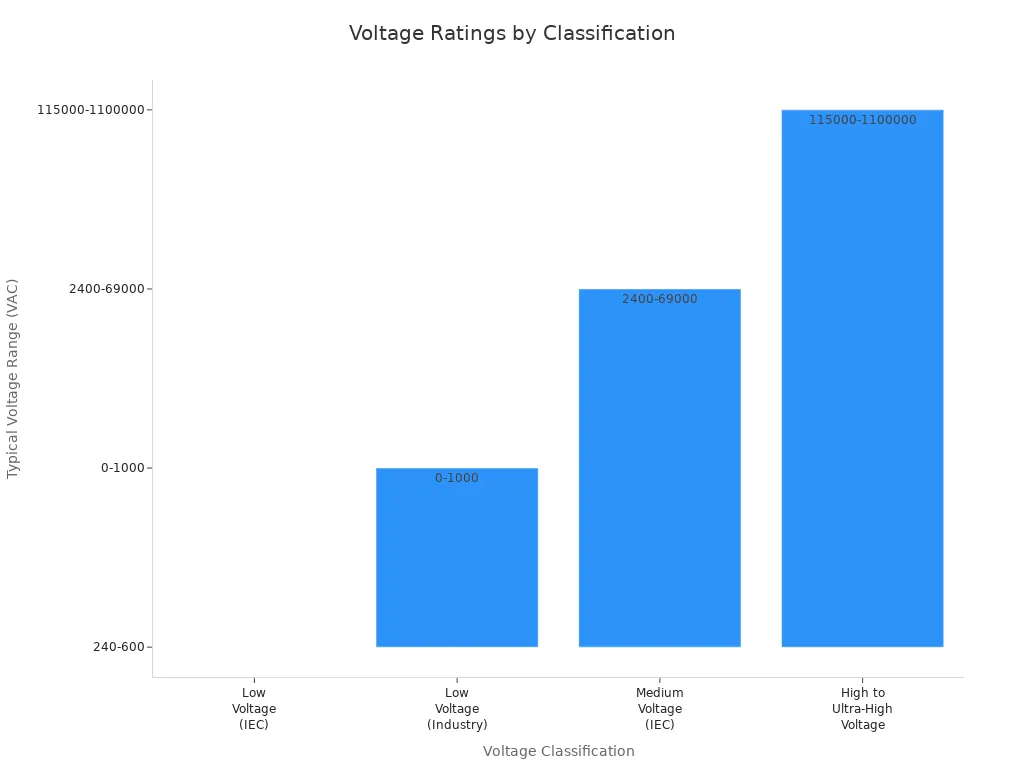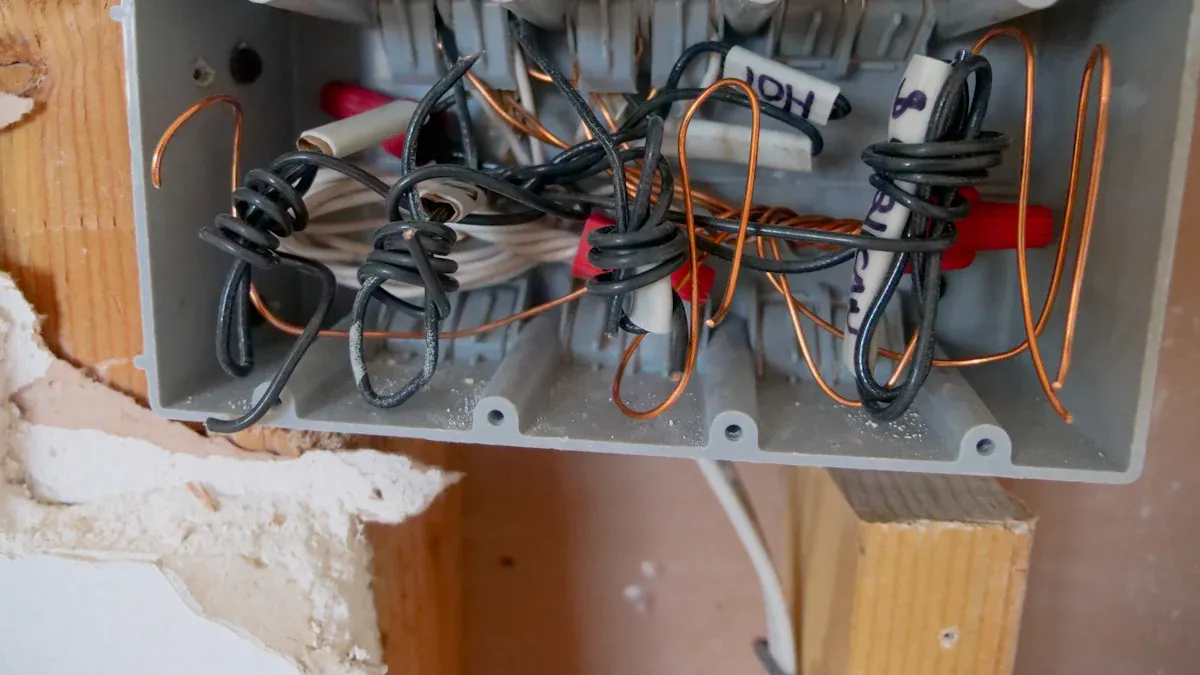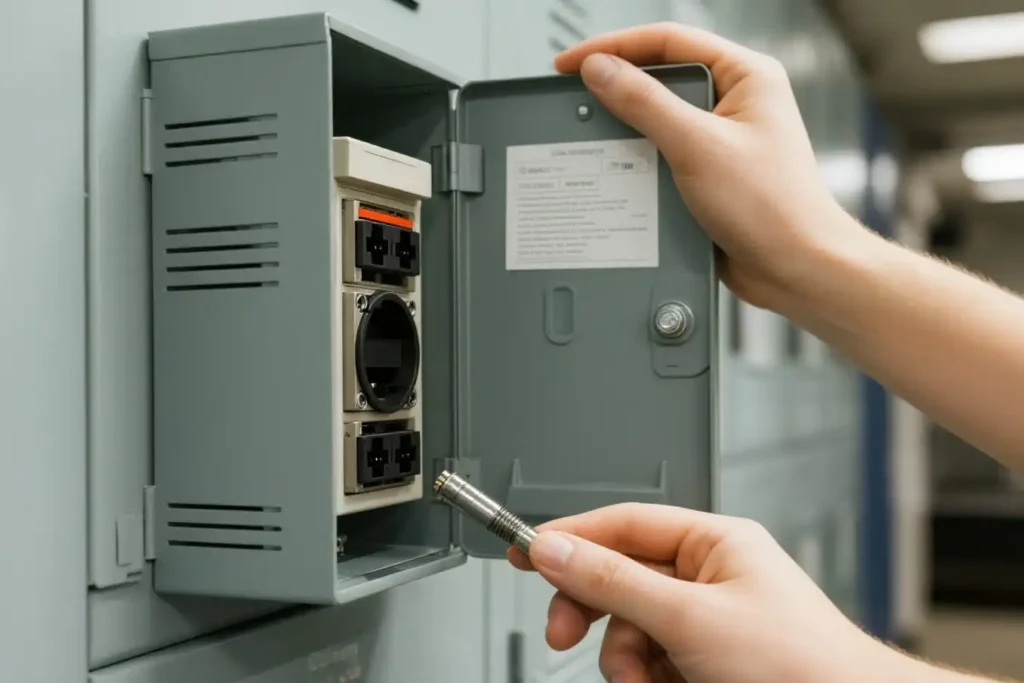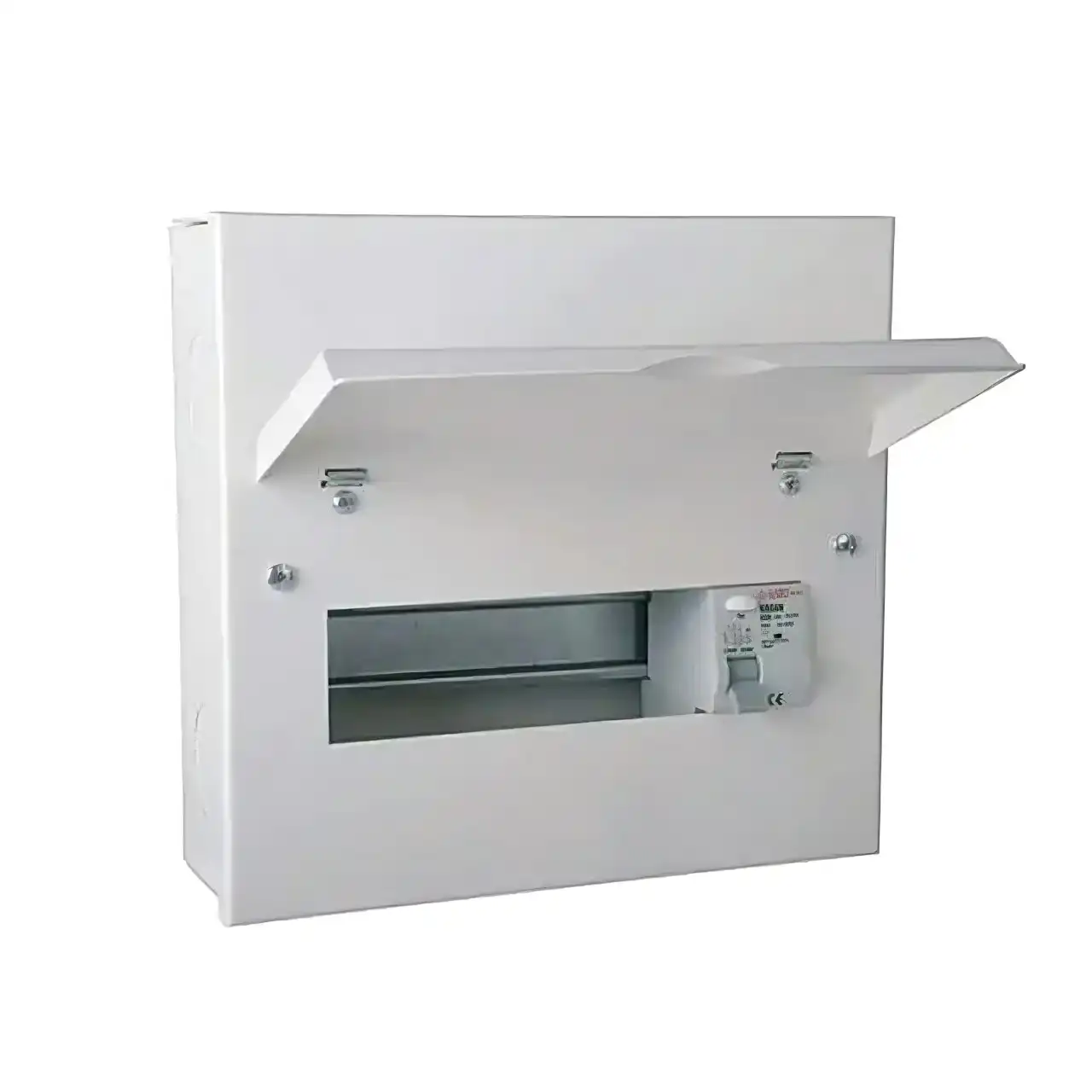A low-voltage box is for wires with less power than a regular electrical box. You use a low-voltage box for doorbells, internet cables, or speakers. Regular electrical boxes hold wires for outlets and switches. These run your lights or appliances. Knowing the difference helps you choose the right box. This choice keeps you safe and stops wiring mistakes.
Key Takeaways
- Low-voltage boxes hold wires for things like internet or speakers. Regular electrical boxes hold wires for outlets and switches. These wires carry more power.
- Low-voltage boxes are made of light plastic. They have open backs so you can reach the cables easily. Regular electrical boxes are made of strong plastic or metal. This keeps electrical wiring safe.
- Keep low-voltage wires and high-voltage wires apart. This stops interference and lowers the chance of fire.
- Always follow electrical codes. Look for safety marks like UL or ETL. These marks show the boxes are safe to use.
- Picking the right box keeps your home safe. It helps you pass inspections. It also makes wiring easier to handle and fix.
Definitions
Low-Voltage Box
A low-voltage box holds wires that do not carry much power. You use this box for phone lines, internet cables, doorbells, or speaker wires. These boxes do not need to handle a lot of electricity. Most are made from light plastic. They often have open backs or soft sides. This makes it easy to put cables through walls. You do not use these boxes for outlets or switches for lights or appliances. You use them to keep low-power wires safe and neat.
Tip: Always keep low-voltage wiring away from high-voltage wiring. This helps stop interference and keeps your setup safe.
Regular Electrical Box
A regular electrical box holds wires for outlets, switches, and other things that use normal household electricity. You use these boxes for circuits that power lights, appliances, or other equipment. These boxes must follow strict safety rules. Regulatory agencies use a system to decide where you can use a regular electrical box. This system checks for dangerous materials and the risk of fire or explosion.
Here is a table that shows how agencies sort areas for electrical boxes:
| Classification Aspect | Description |
|---|---|
| Class (Material Type) | Class I: Flammable gases, vapors, or liquids Class II: Combustible dust Class III: Ignitable fibers |
| Group (Material Properties) | Group A: Acetylene Group B: Hydrogen Group C: Cyclopropane, ethyl ether Group D: Acetone, butane, propane, hexane, natural gas, fuel oil Group E: Combustible metals Group F: Carbon-based materials Group G: Flour, starch, plastic |
| Division (Likelihood of Hazardous Atmosphere) | Division 1: Hazard is there under normal conditions Division 2: Hazard is there only if something goes wrong Nonclassified: Hazard is rare or not there |
You use a regular electrical box in areas where dangerous materials are not found. The steps for deciding where to use these boxes are:
- Gather codes, rules, and diagrams for the area.
- Find any flammable or burnable materials.
- Check if the area needs special sorting.
- Look for places where dangerous materials could leak.
- Assign a class and group based on the chemicals there.
- Decide if the area is Division 1 or 2.
- Mark the edges for sorted areas.
- Use walls or floors to split spaces.
- Write everything down for safety checks.
You should always use a regular electrical box in safe places for normal electrical wiring.
Key Differences

Design & Materials
You can tell these boxes apart by how they look and what they are made of. A low-voltage box is made from light plastic. It might have an open back or soft sides. This makes it easy to pull cables through walls. These boxes do not need to be very strong. They do not carry much power, so heavy protection is not needed.
A regular electrical box is made from strong plastic or metal. It has a solid back and hard sides. This box protects wires that carry more power. The tough material helps stop fires and keeps you safe from shocks.
Note: Always look for a UL or ETL mark on the box. These marks mean the box is safe to use.
Voltage & Safety
The voltage rating shows how much power a box can handle. A low-voltage box works with circuits up to 600 volts. Most homes use much less, like 12 or 24 volts. Regular electrical boxes work with normal home power, like 120 or 240 volts.
Here is a table that shows common voltage ranges:
| Voltage Classification | Typical Voltage Range (VAC) |
|---|---|
| Low Voltage (IEC) | 240 to 600 |
| Low Voltage (Industry) | Up to 600 (commonly) or up to 1000 |
| Medium Voltage (IEC) | 2,400 to 69,000 |
| High to Ultra-High Voltage | 115,000 to 1,100,000 |

Each box type has its own safety rules. You must keep low-voltage wires away from high-voltage ones. This stops problems and lowers fire risk. Low-voltage boxes use special wire that does not crack or melt. Regular electrical boxes must be grounded and fireproof. Both types need to pass checks to make sure they are safe.
| Safety Feature | Low-Voltage (Class 2) Boxes Requirements | Regular Electrical Boxes Requirements |
|---|---|---|
| Power Supply Wattage Limits | 12V DC drivers ≤ 60W; 24V drivers ≤ 96W; must be Class 2 compliant | No specific wattage limits tied to Class 2 rules |
| Separation of Circuits | Must be physically separated from high-voltage circuits | Not required to separate by voltage class |
| Junction Boxes | Must encapsulate connections and be safe, grounded, fireproof | Standard junction boxes for high voltage wiring |
| Wiring Type | Must use Class 2 In-Wall Rated Wire | Typical hardware store wire used |
| Certification of Fixtures | Must be certified by NRTL (e.g., UL, ETL) | Fixtures generally require UL or equivalent certification |
| Inspection and Compliance | Inspections verify separation, wiring rating, enclosure safety | Standard electrical inspections apply |
Applications
You use a low-voltage box for many low-power jobs. Here are some examples:
- Network cables, like Ethernet or CAT 6
- Telephone lines and cable TV
- HVAC controls for heating and cooling
- Tools for measuring temperature or pressure
- Home or business automation systems
- Lighting for small fixtures and devices
A regular electrical box is used for:
- Power outlets for plugging in things
- Light switches for room lights
- Ceiling fans and other big fixtures
Tip: Always pick the right box for your job. This keeps your wires safe and helps you pass checks.
Low-Voltage Box Purpose

Protection & Organization
A low-voltage box keeps your cables and devices safe. It stops wires from getting crushed or bent. The box protects against bumps, dust, and water. You can use conduit or cable raceways with the box. These help stop cables from getting tangled or broken.
- You put your cables in the box to keep them neat. This makes it simple to label and find each wire.
- You keep different cables apart in the box. This helps stop problems with your internet or speakers.
- You use shielding, like copper braid or foil, to block bad signals. This helps your devices work better.
- You keep low-voltage wires away from high-voltage wires. This lowers the chance of electrical noise and keeps things safe.
- You add surge protection and grounding to the box. This keeps your devices safe from power spikes.
Tip: Good cable management helps you fix problems faster. It also makes upgrades easier in the future.
Using a low-voltage box helps your system last longer. Checking and cleaning the box keeps everything working well. You stop overheating, loose wires, and other problems that can cause damage.
Code Compliance
You must follow electrical codes when you use a low-voltage box. These rules keep you and your things safe. The National Electrical Code (NEC) gives steps for using these boxes.
- You use boxes made from strong, safe materials. This stops fires and keeps the box tough.
- You pick a box that fits all your wires. This stops crowding and overheating.
- You keep low-voltage and high-voltage wires in different boxes or conduits. The NEC says they must be at least 12 inches apart.
- You make sure all boxes are easy to reach for checks and repairs.
- You ground the box if the code says you need to. This keeps you safe from shocks.
- You close covers tightly. This stops people from touching live wires by mistake.
Some new code updates let you use metallic boxes for some low-voltage systems. You must follow inspection rules if you do this. Some cities, like New York, have extra rules for communication cables. Always check local codes before you start your project.
Note: Getting help from a pro and having regular checks keeps your system safe. This lowers risks and helps your system work well.
Why It Matters
Safety
You protect yourself and others when you use the right electrical box. The correct box keeps live wires covered and stops you from touching dangerous parts. If you use the wrong box, you risk electrical shock, fire, or even electrocution. Here are some common safety risks:
- Leaving boxes open or not closing unused openings
- Exposing live electrical parts
- Not enough space around boxes
- Poor strain relief on cords
Always close every opening in your electrical box. Never just tape over holes. This keeps you safe and follows OSHA rules.
A proper box cover also blocks dust, water, and dirt. This helps prevent fires and keeps your system working well.
Installation Quality
Good installation starts with the right box. You make your wiring last longer and work better when you choose the correct type. The right box fits your wires and devices. It also matches the place you install it, like indoors or outdoors. Using the right materials, such as plastic or metal, adds strength and protection.
A well-installed box keeps wires neat and easy to reach. You avoid tangled wires and make repairs simpler. Tamper-resistant covers stop others from messing with your wiring. You also meet local and national codes, which means your work passes inspections.
Choosing the Right Box
You need to match the box to your project. Ask yourself these questions:
- What kind of wires will you use? (High-voltage or low-voltage)
- Where will you install the box? (Inside, outside, wet, or dry area)
- How many wires or devices will go inside?
- Do you need extra features, like tamper resistance or weatherproofing?
Tip: If you are not sure, check the National Electrical Code or ask a licensed electrician.
Picking the right box keeps your home safe and your wiring strong. You avoid costly mistakes and lower the risk of hazards.
You now know that a low-voltage box works for low-power wires, while a regular electrical box handles outlets and switches. Picking the right box keeps your home safe and helps you pass inspections. Use this table to guide your choice:
| Tip | What You Should Do |
|---|---|
| Box Fill | Avoid overcrowding to prevent overheating. |
| Material | Use plastic for non-metallic cables, metal for metal-clad. |
| Separation | Never mix low-voltage and regular wires in the same box. |
| Location | Match the box to where you install it and what it will hold. |
Always check local codes or ask a licensed electrician if you feel unsure. This step helps you avoid mistakes and keeps your project safe.
Choose ONESTOP distribution box: With over 20 years of manufacturing experience, international certification assurance, and excellent quality, we help you comprehensively improve circuit safety protection.
FAQ
What makes a low-voltage box different from a regular electrical box?
A low-voltage box holds wires for things like internet or speakers. A regular electrical box holds wires for outlets or switches. You use each box for different power levels and safety needs.
What happens if you use the wrong box for your wiring?
You risk fire, shock, or failed inspections. The wrong box may not protect your wires or devices. Always match the box to your wiring type for safety.
What should you look for when choosing an electrical box?
Check the voltage of your wires. Look for UL or ETL marks. Make sure the box fits your cables and matches the location. Use this table for quick tips:
| Feature | What to Check |
|---|---|
| Voltage | Low or regular |
| Material | Plastic or metal |
| Location | Indoors or outdoors |
What types of projects need a low-voltage box?
You need a low-voltage box for home theaters, internet wiring, security systems, or doorbells. These projects use low-power wires that do not need heavy protection.
What codes or rules must you follow for electrical boxes?
You must follow the National Electrical Code (NEC) and local rules. These codes keep your wiring safe and help you pass inspections. Always check before you start your project.
The following information may be of interest to you
Common Scenarios for Using ACB in Power Distribution
Choosing a suitable distribution box and what should be noted
What Makes Distribution Boxes and Fuse Boxes Different





